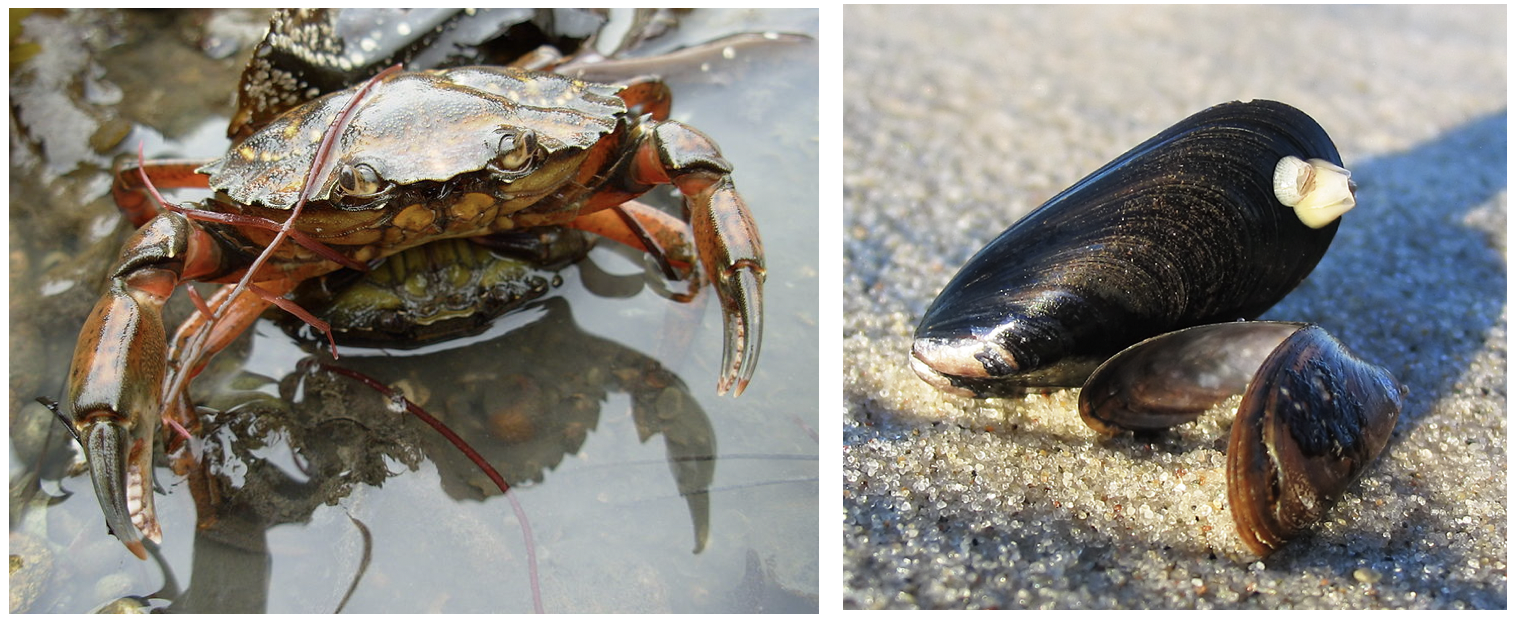4.3: Resource Acquisition in Animals
- Page ID
- 62275
Resource acquisition operates somewhat differently in animals than in plants. As heterotrophs, animals must consume all nutrients they require, including glucose. Animals have a variety of acquisition strategies available to them, depending on which trophic level and ecosystem they inhabit.
Types of Feeders
Animal resource acquisition strategies can be categorized in several ways. First, we might consider categorizing animals by what types of foods they eat. For example, herbivores consume plant material, carnivores consume animal material, and omnivores consume both. Each of these categories can be broken down more specifically. Among carnivores, there are piscivores which eat only fish and insectivores which eat only insects, as well as many other categories. Similarly, among herbivores, there are frugivores which eat only fruit, and granivores which eat only seeds, as well as many other categories. Another important grouping is the detritivores which consume detritus, or decaying dead plant an animal material. Detritivores are very important in nutrient cycling, and include organisms such as fungi, bacteria, earthworms, etc. Each of these strategies are associated with adaptations for increasing the effectiveness of that strategy. For example, herbivores often have symbiotic bacteria in their gut and particularly long intestinal tracts in order to break down the cellulose found in plant cell walls. Additionally, carnivores have a wide variety of adaptations for detecting, capturing, and consuming prey.
Animals can also be categorized by how they obtain the foods they consume. For examples, suspension or filter feeders filter particles of food from the surrounding water. Deposit feeders consume material deposited in the soil or sediment and are often also detritivores. Symbionts live in close association with another organism (their host) and obtain their nutrients from that organism. Symbionts can be parasitic (such as tapeworms) or mutualistic (such as the cellulose-digesting bacteria in the gut of herbivores). Perhaps the most well-known strategy for obtaining food is predation in which animals use stealth or active hunting to kill and consume other animals. This category can also be broken down into more specific strategies. For example, ambush predators use stealth and/or camouflage to hide from their prey and attack only when prey accidentally come near enough for the predator to capture or ambush. Spiders that hunt with webs are an example of ambush predators. Pursuit predators, however, actively chase fleeing prey. These two strategies have their own trade-offs; pursuit predation requires intensive energy investment in chasing down prey without guarantee of capture, while ambush predators must wait for potentially long time periods until prey come into their reach.
As can be seen in these definitions, various levels of specificity exist in both our definitions and in the strategies animals employ. Some animals are specialists, focusing on a particular strategy and/or food source. For example, pandas eat only bamboo and termites eat only wood (though from a variety of species). Other species are generalists and employ a wide variety of food sources and strategies. Bears, for example, are famous for their predation and also their love of berries. Goats and sharks notoriously eat things that are not even digestible food. The diets of many reptiles, such as lizards and snakes are what scientists call ‘gape-limited’ meaning they consume whatever fits inside their gaping mouths. Generalism and specialism have their own trade-offs. A specialist may struggle to find food that they can consume; however, they can also tailor their strategy to most effectively take advantage of a single food source. The anteater, for example, would have a difficult time consuming most types of prey, but is extremely effective at collecting ants. A generalist, on the other hand, can likely eat many things that it comes across in the ecosystem; however, it may not use those food sources as efficiently or effectively as a specialist.
Optimal Foraging Theory
Each food source and each consumption strategy have a balance of nutritional benefits and energetic costs. Ideally, an animal would choose food sources and strategies that maximize the nutritional benefits and minimize the energetic costs. Optimal foraging theory quantifies the benefits (in terms of energy content) of various prey choices and the costs (in terms of energy inputs for capturing, consuming, and digesting food) in order to predict the most energetically beneficial foraging choice. For example, consider a population of shore crabs (Carcinas maenas) that primarily feed on blue mussels (Mytilus edulis, Figure \(\PageIndex{1}\)).

In order to consume the meat of the mussel, the crab must crack open its shell. Large mussels are more difficult to crack open, but contain more meat. Smaller crabs take more time and expend more energy in breaking open mussels than larger crabs. Consequently, what size of mussel provides the optimal energy return on the crab’s energy investment depends on the size of the crab. Scientists quantified the amount of time it took for crabs of various sizes to crack open mussels of different size as well as the nutritional benefit of mussels of different size and used these data to estimate the value of different size of mussel prey for different sizes of predator crabs (Figure \(\PageIndex{2a}\)). Scientists then tracked prey choice by crabs when presented with a variety of prey sizes and discovered that actual prey choice closely matched the patterns of prey value estimated by optimal foraging theory (Figure \(\PageIndex{2b}\)).

Optimal foraging theory focuses entirely on energy costs of feeding and energy return from prey tissue consumed. Other environmental factors may drive predators to make choices different from what optimal foraging theory predicts. For example, if capturing high quality prey items exposes the predator themselves to danger (their own predators, for example), then animals may choose less energetically valuable prey in safer areas of the habitat. Additionally, some plants contain rare nutrients that herbivores require in their diet and so grazers may seek out these plants even if they are not energetically as beneficial.
Image Credits


